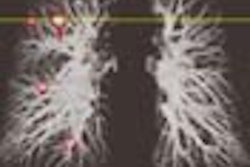Double-read virtual colonoscopy is significantly more sensitive for detecting colorectal polyps than flexible sigmoidoscopy or the fecal occult blood test (FOBT), according to researchers from the Mayo Clinic in Rochester, MN. But a low prevalence of polyps may have hindered the radiologists' ability to find them.
Identifying the combination of screening techniques that provide good results and high patient acceptance at the lowest possible cost is an important goal of colorectal cancer research.
Dr. Daniel Johnson and his colleagues at Mayo sought to evaluate several recommended colorectal cancer screening techniques. "The purpose of our study was to estimate the sensitivity of CT colonography (virtual colonoscopy) in a screening population, and to compare such estimates with a single-stool FOTB and flex(ible) sig(moidoscopy), using colonoscopy as the gold standard," Johnson said at the 2002 RSNA meeting in Chicago.
The group recruited 703 outpatients 50 years of age and older (63% male, 37% female, average age 64) who were scheduled for colonoscopy. The subjects were considered to be at higher-than-average risk of colorectal cancer; however, all were asymptomatic.
All patients had single-stool FOBT. Then, following standard bowel preparation, the subjects underwent conventional colonoscopy followed by same-day virtual colonoscopy in both prone and supine positions.
Most of the subjects received the antispasmodic glucagon, and all underwent manual insufflation of the colon with CO2. Using a LightSpeed multislice CT scanner (GE Medical Systems, Waukesha, WI) the group performed a low-dose VC protocol at 4 x 5-mm slice thickness and 2.5-mm reconstruction in all patients.
Conventional colonoscopy served as a surrogate for flexible sigmoidoscopy, in which colonoscopy-detected polyps in the rectum, sigmoid, and descending colon were counted as flexible sigmoidoscopy results, Johnson said.
"We read the CT exams using customized (GE) software from our institutions," he said. "We routinely evaluated the axial images using both bone and soft-tissue windows. Three MPRs (multiplanar reformatting) and 2 endoluminal views were used for problem-solving to improve our confidence."
Each exam was read by 2 or 3 independent readers blinded to the results of colonoscopy, and all colonoscopy results were read on the same day as the gold standard, Johnson said.
According to the results, conventional colonoscopy detected 94 lesions 5-9 mm in size, and 59 lesions 10 mm and larger, Johnson said. In comparison, virtual colonoscopy found 51 (54%) of polyps 5-9 mm in size, and 37 (64%) of polyps 10 mm and larger. Flexible sigmoidoscopy (based on the distal 60 cm of conventional colonoscopy) detected only 36 (38%) of polyps 5-9 mm, and 18 (31%) of the polyps 10 mm and larger.
As for FOBT, although "there were 117 proven polyps over 5 mm in size, surprisingly, the hemoccult test was negative in all (541) cases (P<0.001)," Johnson said. Double-read virtual colonoscopy had a specificity of 95% for polyps 10 mm and larger, and 85.5% for polyps 5-9 mm.
In all, 25% of the subjects had a family history of colorectal cancer, 73% had a personal history of cancer or polyps, and 2% had asymptomatic anemia. Nevertheless, just 8% were found to have polyps; just 5% had adenomas.
"I think this is the first large study in a screening population where the prevalence of large adenomas was only 5%," Johnson said. "I think our reading methods could potentially be criticized since we just looked at the axial images (consistently), and only looked at the MPRs and 3-D endoluminal views for problem-solving. Could we have done better with other reading methods? I think that remains to be established. This is certainly the reading method that 's been endorsed by most CT colonography experts."
And the bowel prep wasn't perfect. Overall, about 70% of the subjects had optimal colonic distension, the remaining ones had suboptimal distension, and a significant minority of patients had a moderate amount of fluid remaining in the colon.
The results showed significant interreader variability, ranging from 30%-60% in the 5-9 mm polyps, and from 30%-70% in polyps 10 mm and larger. Double-reading proved to be extremely helpful in compensating for this variability while preserving almost all the sensitivity of the best reader, Johnson said.
Adding a second reader improved virtual colonoscopy's sensitivity by 19%-29%, depending on polyp size, and although the 98% specificity for the larger lesions dropped a bit with the addition of a second reader, it remained strong at 95%, Johnson said.
"The wide interobserver variability is seen in many other radiology tests -- it's no wonder it exists in this one as well," Johnson said. "Certainly one of the reasons may be that we have to look at an awful lot of data to find a single polyp. We estimated that we're looking at about 13,000 slices before we find a single 1-cm polyp. It's kind of like finding a needle in a haystack, and so it's no wonder that some people do better under that challenge than others. Hopefully CAD will help us."
Virtual colonoscopy is significantly more sensitive for the detection of polyps than FOTB or flexible sigmoidoscopy, identifying 64% of polyps 10 mm and larger in the study, Johnson concluded.
By Eric BarnesAuntMinnie.com staff writer
February 21, 2003
Related Reading
Workflow issues key in virtual colonoscopy, January 15, 2003
Low-dose CT colonography accurately detects large colorectal neoplasms, July 30, 2002
Copyright © 2003 AuntMinnie.com




















